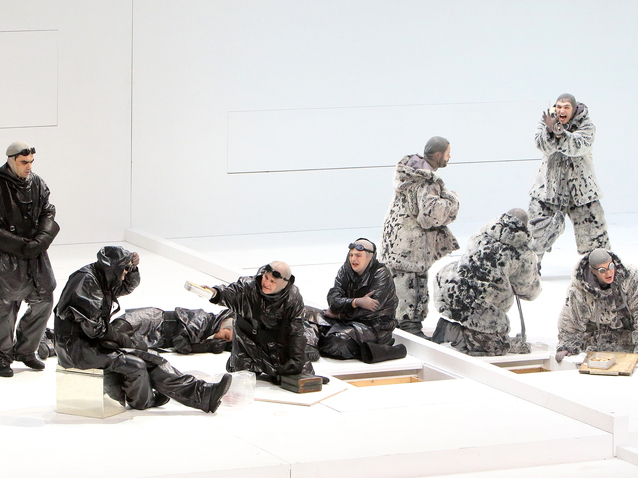 © Winfried Hösl
© Winfried Hösl
The Center of Munich ıs currently full of antarctic fever expecting the world premiere of South Pole, an opera by young Czech composer Michael Srnka, a special order of the Bavarian State Opera. The cool, decorless big space in front of the opera house has been acoustically converted by a sound installation presenting calving glaciers, roaring whales or polar bears, icy snow storms and everything else to be heared on the coldest continent.
An imitation of Amundsen's tent, installed at the South pole has been set next to the monument of the Bavarıan king. So the curious audience is already sensibilized on the way to the performance, expecting the musical transmission of the world most famous but tragic race of the British crew led by Robert Scott and the Norwegian crew under Roald Amundsen in 1911.
A crew of international stars has been selected to perform this musical exploration. Mexican tenor Rolando Villazon is back on stage as the sensible, charming audacious adventurer Scott and shows his acting talent and his voice glides warmly along the bizarre music full of staccato sound jumps. Thomas Hampson represents the tough, calculating emotionless self-made-man Amundsen in his noble stature and his full gentle bariton.
Very experienced Hans Neuenfels took over the direction of the world premiere and the stage design by Katrin Connan and himself is a tribute to the bare monotonous nature of the icy continent and houses the plot in a bright white construction.
The story starts without introduction with the morse telegram of Amundsen received by Scott and so the race is open. The brilliant libretto of Tom Holloway packs the voluminous story in short scenes continuously flowing, creating an exciting documentation of the enormous physical performance of all participants as well as the psychological pressures.
Most surprisingly the inner side of the two main characters, their emotions and personal life experiences and love relation get a broad presentation and develop to the actual theme of the piece. Very sensible and fine definitions of the characters in simple and small moments are most expressive and create a dense and vibrant excitement within the audience. Next to the hard efforts of both teams in arriving at the pole, their rare distractions, the loss of their supporting animals, ponies for the Brits and dogs for the Norwegians, Scott meets his beloved wife Kathleen - fine and distinct Tara Erraught, already dressed up as the mourning widow and Amundsen encounters his difficult relation to a nameless landlady - sharp and colorless Mojca Erdmann. Full of human feelings are the final scenes of Scott finishing his diary facing death and Amundsen finally deeply moved by his feelings after having received the note of Scott's death and dedicating the pole to his competitor, making the race an immortal event and Scott to the real hero.
The music of Miroslav Srnka is embedding the story into a cool and most technically sound coverage. The harmonic composition seems spheeric but lacks an elaborated instrumentation. No Doubt about monotony in an antartic environment but scenes full of emotion and inner conflict do not find their counterpart in the music. The singers have to concentrate on their distinct punctuated melody of continuous up and downs in a robot like staccato. Melodic or rhythmic enrichments are seldom used as accompanying means of style.
Highly regarded Kyrill Petrenko, musical head of the Bavarian State Opera, masters the musical realisation in the orchestra pit. His sensibility for modern music and the fine interpretation with accurate tempi and volumes supports the vibrant action on stage. The audience follows the concept of the composer and artistic team with affection and concentration, the final applause is verifying the success of the idea and its transfer into a modern opera and merits heartily the performance of all participants.
Helmut Pitsch
the 02 of February, 2016 | Print
Comments